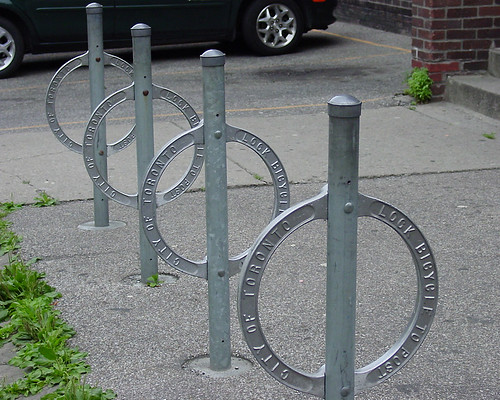Bike stuff

Image: NDP Leader Jack Layton and his wife, MP Oliva Chow, rode a tandem bike down Yonge St. during the 2005 Gay Pride parade.
TORONTO STAR FILE PHOTOIf we want to continue this cycle of encouraging people to cycle, we can take a few key steps.
Keep expanding. The District is adding 25 stations, Arlington 30, Rockville 20. More would be better, and Alexandria, College Park, Bethesda, Fairfax and others should join.
Add bike lanes and “cycle tracks.” Novice cyclists feel especially vulnerable on the roads. Bike lanes, especially the “cycle tracks” on 15th Street and Pennsylvania Avenue NW, help. The D.C. Department of Transportation has wavered on adding similar lanes elsewhere downtown. It should move decisively to build them and to complete the 60 miles of lanes in the city’s Bicycle Master Plan. Other jurisdictions can do likewise.
Don’t cut federal bike (and pedestrian) funding. Twelve percent of all trips nationwide happen by bike or on foot, but states spend just 1 percent of transportation funds on bike and pedestrian facilities. Yet Congress is looking at eliminating dedicated bike/pedestrian funding entirely.
Add stations on federal property. Look at the Bikeshare map, and you see a giant hole amid Crystal City, Rosslyn and downtown D.C. It’s called the Mall and its associated parks. Yet the memorials are almost perfect places for stations.
I think the lesson from Montreal is that the creation of a cycletrack network is an absolute necessity for increasing bike uptake in a significant fashion. The emphasis should be on "network." A couple lanes or tracks here and there does not a network make.
2. It turns out that the recently deceased leader of Canada's New Democratic Party, Jack Layton, was an initiator of the pro-bike sustainable transportation agenda in the City of Toronto, beginning in the 1980s. See "Jack Layton saw the future and it was on a bicycle" from the Toronto Star.
Turns out he was one of the inventors of the "post and ring" device used on parking meters to provide bike parking. How many elected officials have actually created something so tangible and useful? And risen up to be the leader of their political party. Sure President Obama and President Bush ride bikes, but it's not the same.

Post and ring bike racks in Toronto. Photo: Richard Drdul, on Flickr.
3. There is pushback on biking in Montreal as all those damn bicyclists are pissing off motor vehicle drivers, and getting killed too. See "The Downside of Urban Cycling: We need to make it safer but we also need to ask if the public sanctification of biking is warranted" by columnist Henry Aubin of the Montreal Gazette. One response to the piece, "Paying for Convenience," made the very good point that providing higher quality bike parking would increase the use of biking.
The problems according to Aubin:
First, as this week's accidents underscore, bike riding in Montreal is inherently risky. Police say an average of 800 people are injured on bikes every year on Montreal Island. ...
Second, bike riding here is not as environmentally virtuous as it's cracked up to be.
One premise for creating the Bixi was to get people out of cars, but a McGill study last year found that the bikesharing service replaces only two per cent of trips by car. Very few commuters on non-Bixi bikes are also exmotorists. They're ex-transit customers.
Third, many cyclists behave as irresponsibly as Montreal's notorious drivers, perhaps even worse. ...
Fourth, urban cycling is no friend of the taxpayer. ... Consider, too, the way "little" things can add up: the cost of treating those 800 injuries a year, the Société de transport de Montréal's loss of fares from people who would otherwise travel on public transit, the loss of revenue caused by replacing hundreds of parking spots with the Bixi.
I can't imagine that there are more accidents involving bicyclists than motor vehicles in Montreal, but people don't call for driving to be banned. Similarly, transgressions by "the other" seem a lot worse than the transgressions by the not-other.
4. Tomorrow's New York Times real estate section makes the point that more people are asking about bike storage issues when looking for apartments and condominiums, "The Bike Muscles In."
5. The Times also has a long piece about electric biking in Switzerland, "Over the Alps on a Bike With a Boost." The between the lines piece is that they have a system that promotes bike tourism generally, and a system of electric biking rental too, to the point where you can switch out batteries if you're running low.
Certain places, such as Quebec in North America, have focused on developing bike tourism systematically. It's been done at the county level in the U.S., but not so much at the state level, although I guess Pennsylvania's Trail Towns initiative is an exception.
6. And two pieces in the Post over the past couple days mention biking, including on the Baltimore & Annapolis Trail ("Roads less traveled") and maybe a real estate story.
Motorists and cyclists both break the law; unfortunately it's the motorist who will go to jail if the two collide. No wonder motorists are unnerved driving around cyclists.
But, motor vehicle drivers should be held to a higher level of responsibility for accidents, concomitant with the power of the motor vehicle to damage, maim, and kill.
Labels: bicycle sharing, bicycling, car culture and automobility, sustainable transportation



0 Comments:
Post a Comment
<< Home